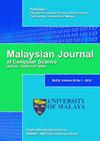B-LSTM-NB BASED COMPOSITE SEQUENCE LEARNING MODEL FOR DETECTING FRAUDULENT FINANCIAL ACTIVITIES
IF 1.2
4区 计算机科学
Q4 COMPUTER SCIENCE, ARTIFICIAL INTELLIGENCE
引用次数: 0
Abstract
Deep Learning (DL) in finance is widely regarded as one of the pillars of financial services sectors since it performs crucial functions such as transaction processing and computation, risk assessment, and even behavior prediction. As a subset of data science, DL can learn and develop from their experience, which does not require constant human interference and programming, implying that the technology will improve quickly. By loading an Ensemble Model (EM), a Deep Sequential Learning (DSL)model, and additional upper-layer EM classifier in the correct order, a new “Contained-In-Between (C-I-B)” composite structured DSL model is recommended in this article. In cases like Fraud Detection System (FDS), where the data flow comprises vectors with complex interconnected characteristics, DL models with this structure have proven to be highly efficient. Finally, by utilizing optimized transaction eigenvectors, a NB classifier is trained. This strategy is more effective than most standard approaches in identifying transaction fraud. The proposed model is evaluated for its accuracy, Recall and F-score, and the results show that the model has better performance against its counterparts.基于B-LSTM-NB的检测欺诈金融活动的复合序列学习模型
金融领域的深度学习(DL)被广泛认为是金融服务业的支柱之一,因为它执行着交易处理和计算、风险评估甚至行为预测等关键功能。作为数据科学的一个子集,DL可以从他们的经验中学习和发展,这不需要持续的人为干扰和编程,这意味着该技术将迅速改进。通过以正确的顺序加载集合模型(EM)、深度序列学习(DSL)模型和额外的上层EM分类器,本文推荐了一种新的“包含在中间(C-I-B)”复合结构DSL模型。在像欺诈检测系统(FDS)这样的情况下,数据流包括具有复杂互连特征的向量,具有这种结构的DL模型已被证明是高效的。最后,利用优化后的事务特征向量对NB分类器进行训练。在识别交易欺诈方面,这种策略比大多数标准方法更有效。对所提出的模型的准确性、召回率和F分数进行了评估,结果表明该模型与同类模型相比具有更好的性能。
本文章由计算机程序翻译,如有差异,请以英文原文为准。
求助全文
约1分钟内获得全文
求助全文
来源期刊

Malaysian Journal of Computer Science
COMPUTER SCIENCE, ARTIFICIAL INTELLIGENCE-COMPUTER SCIENCE, THEORY & METHODS
CiteScore
2.20
自引率
33.30%
发文量
35
审稿时长
7.5 months
期刊介绍:
The Malaysian Journal of Computer Science (ISSN 0127-9084) is published four times a year in January, April, July and October by the Faculty of Computer Science and Information Technology, University of Malaya, since 1985. Over the years, the journal has gained popularity and the number of paper submissions has increased steadily. The rigorous reviews from the referees have helped in ensuring that the high standard of the journal is maintained. The objectives are to promote exchange of information and knowledge in research work, new inventions/developments of Computer Science and on the use of Information Technology towards the structuring of an information-rich society and to assist the academic staff from local and foreign universities, business and industrial sectors, government departments and academic institutions on publishing research results and studies in Computer Science and Information Technology through a scholarly publication. The journal is being indexed and abstracted by Clarivate Analytics'' Web of Science and Elsevier''s Scopus
 求助内容:
求助内容: 应助结果提醒方式:
应助结果提醒方式:


